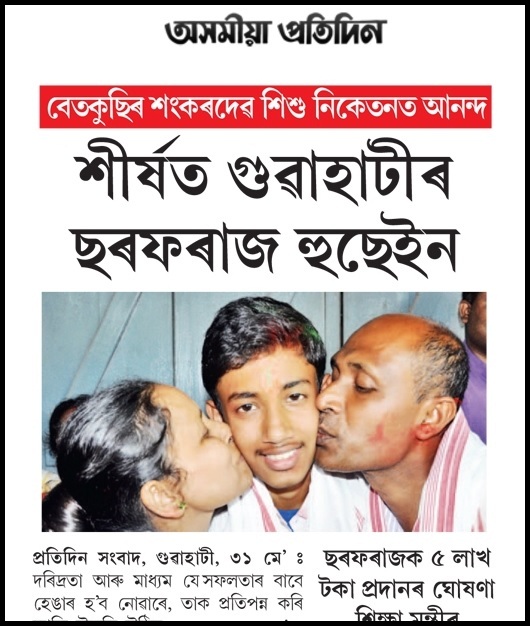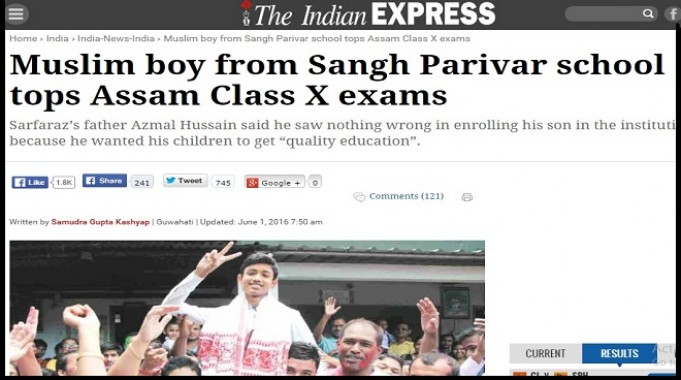Hitting the wrong note in Assam
For the first time perhaps in the history of Assam, high school examination results made it to the headlines of the national media. Sarfaraz Hussain, a student of Sankardev Sishu Niketan, Betkuchi, on the outskirts of Guwahati, topped the Class 10 exam in the state. The regional media reported the results that came out at 11 am on Thursday like any other year but the national media suddenly got interested in the whole thing and that too for a very different reason.
The BJP-led alliance had just swept the polls in the state and the first BJP Chief Minister of the state had just ascended the throne. The rising role of the RSS in the Northeast is already a clichéd topic as it was extensively analyzed and written about in the national media in the run up to, and following, the election results.
What is surprising is the fact that the national media still seems to be in Assam election fever mode, analyzing and reporting every piece of news from the region. Everyone, from NDTV to the Indian Express and Times of India, reported the story of Hussain, highlighted the fact that he is Muslim and that the school where he studied is an affiliate of Vidya Bharati, the RSS’s education wing.
The masala they found in the whole story compelled them to write headlines like ‘Muslim boy from RSS School tops Assam High School Examination’ or ‘Muslim boy from Sangh Parivar School tops Assam Class X exams’. Many of these reporters and editors would like to argue that they are in fact showcasing the communal peace and brotherhood in Assam.
But the fact of the matter is that the damage is already done. The damage was done when such a headline was written and the concerned editors made a decision to go with it. This sends out the wrong message that Muslim boys have never studied in schools like Sankardev Sishu Niketan or haven’t fared well in examinations in the previous years.

Picture credit: Asomiya Pratidin
Why this year then? Just because the BJP is in power, an RSS angle will be the right masala ingredient in this story? Why is it that a normal story, without a wild twist or angle that maligns the Northeast in some way or the other, fails to make it to the national headlines every single time?
Journalists failed to understand that Sankardev Sishu Niketan was the first clue to understanding the Hussain story. The school is named after the great saint ‘Srimanta Sankardev’ (1449-1568) who was a scholar, playwright, and social religious reformer who created a new religious inclination, a form of belief called ‘Ekasarana Dharma’ (shelter-in-one religion, a pantheistic faith) in which he enveloped people of all castes and religions including Muslims.
One of his famous disciples was a Muslim called Chandsai. It is believed that the name of Chandsai was closely associated with the construction of the Barpeta and the Bardowa Satras (Ekasarana institutional centres). As a tribute to Sankaradeva and Chandsai, the followers of Islam in Assam have formed a cultural group, the Chandsai Bhāonā Dal.
In any case, Hindus and Muslims have co-habited in complete harmony in the region for many centuries now and script a completely different narrative in comparison to the larger socio-political narrative of the country.
One teacher from a Sankardev Sishu Niketan School commented, “A huge number of students studying here belong to the Muslim community. We even have Muslim teachers in our school. It is unfortunate that the national media gave a religious angle to Sarfarz’s story. It’s like demeaning his achievement.”
Sankardev Sishu Niketan has 24 Muslim students. Sankardev Sishu Niketan and Sankardev Vidya Niketan are a group of schools run by the Shishu Shiksha Samiti, a state-level affiliate committee of Vidya Bharati which runs about 12,000 schools across India. Of these 12,000 schools, 470 can be found across Assam with thousands of Muslim students.
In 2013, Umme Fardina Ali became the first Muslim woman in 66 years from the Northeast to clear the UPSC examinations with flying colours. Ali did her schooling from Disney Land High School, Khanapara, in the south of Guwahati. Not a single national newspaper, channel or digital platform covered her immense achievement, perhaps because the social and political circumstances of the region were nothing significant at that time or perhaps because she didn’t study in an RSS-affiliated school.
Whatever the reason, this selective reporting of news based on cheap sensationalizing is unfortunate both for the region and for journalism.







